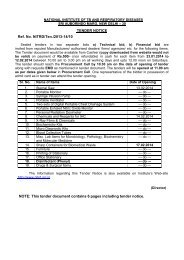The Indian Journal of Tuberculosis - LRS Institute of Tuberculosis ...
The Indian Journal of Tuberculosis - LRS Institute of Tuberculosis ...
The Indian Journal of Tuberculosis - LRS Institute of Tuberculosis ...
Create successful ePaper yourself
Turn your PDF publications into a flip-book with our unique Google optimized e-Paper software.
INDIAN JOURNAL OF TUBERCULOSIS 63<br />
dose <strong>of</strong> INH incorporated in a biodegradable<br />
polymer, the levels <strong>of</strong> the free durg and its major<br />
metabolites, 6 weeks after a single implant, were<br />
similar to those obtained with daily oral administration<br />
<strong>of</strong> the same dose. Homogenates <strong>of</strong> liver<br />
and lungs from animals killed after 6 weeks<br />
showed high antimycobacterial activity against M.<br />
<strong>Tuberculosis</strong>. <strong>The</strong>re were no significant differences<br />
in renal, hepatic and haematological parameters<br />
when sera were tested. Implants did not<br />
cause any local or systemic toxicity.<br />
ASSOCIATION OF PULMONARY TUBERCU-<br />
LOSIS AND HLA IN SOUTH INDIA<br />
V. BRAHMAJOTHI ET AL; TUBERCLE;<br />
1991, 72,123.<br />
Since many <strong>of</strong> us are exposed to mycobacterial<br />
infection which does not result into disease, it is<br />
suggested that hereditary predisposition may be<br />
responsible for the oncet <strong>of</strong> disease. To find out<br />
the relationship between disease and genetic factors,<br />
204 patients with smear positive pulmonary<br />
tuberculosis and 404 healthy controls were studied.<br />
It was found that HLA-A10, B8 and DR2<br />
were more frequent among patients than in 404<br />
control subject (p = 0.01). A primary association<br />
<strong>of</strong> HLA-DR2 in radiologically for advanced,<br />
smear-positive patients has also been identified<br />
(p = 0.001). Thus, HLA-DR2 not only predisposed<br />
for smear-positive disease but also for far<br />
advanced lung lesions. In 152 patients with<br />
smear-negative pulmonary tuberculosis, the frequencies<br />
<strong>of</strong> HLA-A10 and B8, but not <strong>of</strong> DR2,<br />
were greater in the control subjects. <strong>The</strong> study<br />
further revealed other HLA associations (A3,<br />
B12 and DR4) in genetically disparate populations<br />
(caste) unique to them suggesting that genes<br />
linked with the HLA complex might also be significant<br />
in the pathogenesis <strong>of</strong> tuberculosis. This<br />
study, along with others which have revealed a<br />
HLA-DR2 association in tuberculosis and leprosy,<br />
suggests that the mechanism <strong>of</strong> immunogenetic<br />
predisposition to these mycobacterial diseases<br />
may be the same.<br />
SUPERVISED OUT-PATIENT TERATMENT<br />
OF TUBERCULOSIS: EVALUATION OF A<br />
SOUTH AFRICAN RURAL PROGRAMME<br />
M.S. WESTAWAY ET AL; TUBERCLE; 1991.<br />
72140.<br />
<strong>The</strong> paper reports on a supervised out-patient<br />
treatment programme in a predominantly rural<br />
area <strong>of</strong> South Africa for black TB patients. A 3-<br />
year study covering 454 patients showed treatment<br />
completion rates improving from 88% in<br />
the first year to 94% in the third year. <strong>The</strong> rate <strong>of</strong><br />
default was reduced from 8.5% to 3% over the<br />
same period. <strong>The</strong> remaining 3% to 4% <strong>of</strong> the patients<br />
died during the course <strong>of</strong> treatment. Treatment<br />
supervision, after an initial period <strong>of</strong> hospitalisation<br />
was for the vast majority <strong>of</strong> patients,<br />
entrusted to voluntary health workers. <strong>The</strong> rindings<br />
suggest that supervised out-patient treatment<br />
with community involvement and responsible<br />
participation was successful in achieving the aim<br />
viz. holding and curing TB patients.<br />
DIFFERENTIATION OF MYCOBACTERIUM<br />
TUBERCULOSIS STRAINS BY USE A NON-<br />
RADIO ACTIVE SOUTHERN BLOT HYBRIDI-<br />
ZATION METHOD<br />
BRUCE C. ROSS ET AL; JOURNAL OF IN-<br />
FECTIOUS DISEASES; 1991,163, 904.<br />
Currently, the only means <strong>of</strong> distinguishing M.<br />
tuberculosis isolates is by phage typing, which is<br />
impractical for most laboratories. Attempts to<br />
develop an alternative approach based on defining<br />
differences in DNA by detecting restriction<br />
fragment length polymorphisms (RFLP) have not<br />
yielded satisfactory results. Moreover, the earlier<br />
attempts used a costly and health hazard radiosotope.<br />
<strong>The</strong> authors have developed a. non-radioactive<br />
RFLP technique which also differs by using<br />
enzymes that have four base recognition sites<br />
rather than six. Various restriction enzymes such<br />
as Alul, Ddel, Himl, Ndell, Rsal and TaqI were<br />
used to digest genomic DNA. <strong>The</strong> high molecular<br />
weight fragments were visualized after Southern<br />
blotting with digoxigenin-labelled M. tuberculosis<br />
DNA. Among all the enzymes used, AluI showed<br />
the greatest potential by distinguishing all eight<br />
M. tuberculosis isolates and three type strains<br />
from tuberculosis complex, while enzyme Ndell<br />
distinguished all but two strains. <strong>The</strong> other enzymes<br />
used in this study were <strong>of</strong> little help. Thus,<br />
this method is particularly useful where there is a<br />
small amount <strong>of</strong> species diversity and where the<br />
identity or location <strong>of</strong> variable regions within the<br />
genome are not known.

















